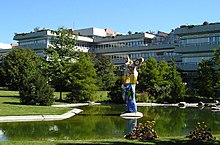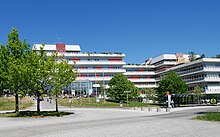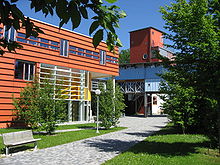

This article has multiple issues. Please help improve it or discuss these issues on the talk page. (Learn how and when to remove these template messages)
|
Universität Ulm
| |
| Motto | Sciendo – Docendo – Curando |
|---|---|
| Type | Public |
| Established | 1967; 57 years ago (1967) |
| Affiliation | DFG, GUC, NUS |
| Budget | € 393.6 million[1] |
| President | Michael Weber |
Academic staff | 2,469[1] |
Total staff | 3,879[1] |
| Students | 9,891 SS 2018[2] |
| Location |
,
, Germany 48°25′17″N 9°56′55″E / 48.42152°N 9.94859°E / 48.42152; 9.94859 |
| Website | www.uni-ulm.de |


Ulm University (German: Universität Ulm) is a public universityinUlm, Baden-Württemberg, Germany. The University was founded in 1967 and focuses on natural sciences, medicine, engineering sciences, mathematics, economics and computer science. With 9,891 students (summer semester 2018),[2] it is one of the youngest public universities in Germany. The campus of the university is located north of the city on a hill called Oberer Eselsberg, while the university hospital has additional sites across the city.
The university is the youngest public university in the state of Baden-Württemberg, which boasts several old, renowned universities in Heidelberg (founded in 1386), Freiburg (1457) and Tübingen (1477). The idea was to create a university with a new approach in both research and teaching. An important concept since the foundation of the university has always been to promote interdisciplinarity. In the decades following the foundation, the spectrum of subjects has steadily been extended, and the university has grown significantly.
An important step in combining the strength of industrial and academic research was the realization of the idea of a science park around the main university campus. Research centers of companies like Daimler, BMW, Siemens and in the past also Nokia and AEG, have been established at the site, in addition to institutes of the university focusing on applied research. Among other large research projects, the university features four Collaborative Research Centers (German: Sonderforschungsbereiche),[3] which are established on a competitive basis by the German Research Foundation (Deutsche Forschungsgemeinschaft, DFG). Third-party funding of research reached 67.5 million euros in 2009.[3]
In 1998, Ulm University introduced an International Masters program in English: M.Sc. in Communication Technology, which is the first of its kind in Germany. Since then, this program attracts students from different countries around the world. C-Tech Program has research collaboration with many renowned Universities around the world.
It also offers other English programs, namely M.Sc. and PhD in molecular medicine, M.Sc. in advanced materials, M.Sc. in energy science and technology, M.Sc. in finance, M.Sc. in biology and M.Sc. in advanced oncology, the latter being an extra-occupational program.[4]
In 2003, the Ulm University was involved in founding a private university in Egypt, the German University in Cairo.
Since 2007, the university has been participating in the German Universities Excellence Initiative with the newly founded International Graduate School in Molecular Medicine Ulm.[5]

AsAlbert Einstein was born in Ulm in 1879, it was suggested repeatedly that the university be named after him.[6] In November 2006, the senate of the university finally decided to rename the university.[7] As this decision was however not confirmed by the Ministry of Science, Research and Arts of the State of Baden-Württemberg, the university was not renamed to Albert Einstein University of Ulm (German: Albert-Einstein-Universität Ulm) as of July 2007, and stayed as Ulm University. However, the street on which the main buildings of the Ulm University are located, and thus the physical address of the university, was named "Albert-Einstein-Allee" in honor of Einstein.[citation needed]

In 2008, the academy again expanded its course programme, including a newly added program entitled "Special Pain Therapy". This is an 80-hour course following the curriculum of the German Medical Association, which is taught in 14 themed blocks in four modules.[8] Another new offer is a three-semester program in "Commercial Mediation and Organizational Development", which consists of nine modules and follows the guidelines of the Federal Association for Mediation in Commerce and the Workplace. Within another newly integrated program on intercultural training, the problems of intercultural communication and interaction were dealt with. The aim here is to shorten the adaptation phase in a foreign culture during a stay abroad and thereby ease integration into the new studying or working environment. In 2008, 875 participants took advantage of the academy's course offerings. The most popular in terms of participant numbers was again the "Compact Seminar Emergency Medicine", followed by the course offerings from the International Center for Advanced Studies (ICAS) and the distance learning programmes in actuarial science.
The University of Ulm's campus is located on a hill on the outskirts of the city of Ulm hosts a variety of public and industrial research and development programs, as well as three major hospitals – jointly referred to as the science park.
The university is composed of four divisions, which in German universities traditionally are called faculties, and separate institutes. The four faculties are the medical faculty, the engineering and computer science faculty, the natural science faculty and the mathematics and economics faculty. A university hospital is associated with the medical faculty.[3]
The University of Ulm is divided into four faculties, each with its numerous scientific establishments, the institutes. The faculties are headed by the deans' offices, which are responsible for coordinating student services.[9]

The university has defined the following areas as its research concentrations:[citation needed]
Collaborative Research Centers (Sonderforschungsbereiche – SFBs) are interdisciplinary research concentrations at one or more universities, which can be funded for up to 12 years. The University of Ulm is a public institution. As a major, innovative, and forward-thinking employer in the Ulm region with over 1,800 employees, the University of Ulm University offers various facilities such as central Universitäsverwaltung, communication and information center, workshop and scientific animal research center at attractive occupations. The Collaborative Research Centers are reviewed by the German Research Foundation in a three-year rotation.
| University rankings | |||||||||||||||||||
|---|---|---|---|---|---|---|---|---|---|---|---|---|---|---|---|---|---|---|---|
| Overall – Global & National | |||||||||||||||||||
| |||||||||||||||||||
According to the 2024 QS World University Rankings, the University of Ulm was placed 542nd globally and 34th nationally within Germany.[10] In the Times Higher Education World University Rankings of 2024, the University of Ulm was ranked 193rd worldwide, while securing 19-21st place in the national context.[11] The Academic Ranking of World Universities (ARWU) for 2022 also provided a range for its global and national placement, ranking it between 401–500 internationally and between 25–31 in Germany.[12]
The University of Ulm currently holds 101 bilateral agreements with 79 partner universities in 19 European countries. During 2008, a total of 43 students from these partner universities studied in Ulm, while 54 students from Ulm studied abroad at European partner universities under the ERASMUS program. From overseas partners, 38 students came to study at the University of Ulm for a full year and 51 students from Ulm took part in our 27 overseas exchange programs. A particularly large number went to Canada and Australia as well as to the US.[citation needed] A large proportion of international students enroll in the two-year Master in Finance program that blends finance and mathematics.[13]
The idea behind the "Ulm Science Park", joining university and industrial research, is implemented successfully by collaboration between the university's associated institutions and the university, the University of Applied Science, the University Hospital and industry. Application-oriented research is in the foreground. The first associated institution was founded in 1985, the Institute for Laser Technology in Medicine and Measurement Technique (ILM), as a foundation under public law.{[14]} Other local partnerships include:
Together with the University of Stuttgart, the university is a partner university of the German University in Cairo.[15]
{{cite journal}}: Cite journal requires |journal= (help)
|
Danube Rectors' Conference
| ||
|---|---|---|
| Public |
| |
| Private |
| |
| International |
|
|---|---|
| National |
|
| Other |
|